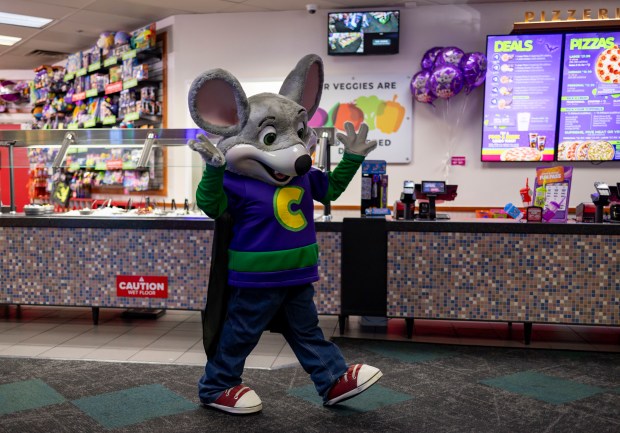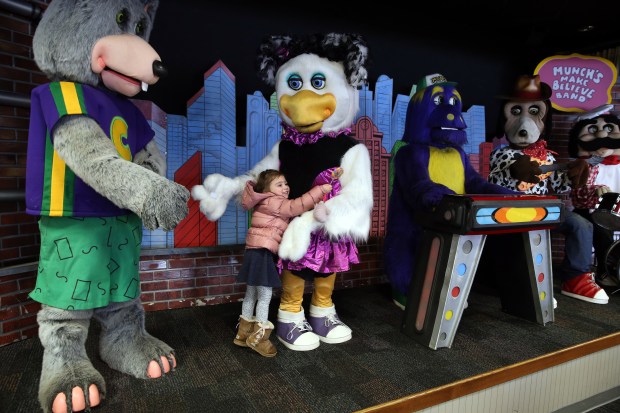A newly remodeled Chuck E. Cheese restaurant opened this week in Gage Park on Chicago’s Southwest Side, promising all the arcade games, screaming kids and pizza-fueled mayhem that parents have come to know and endure.
The missing ingredient? The iconic animatronic house band, a larger-than-life, rodent-led ensemble that has performed nightly at the family entertainment chain for decades, has finally lost its gig.
Once the main attraction, Munch’s Make Believe Band has been phased out at hundreds of Chuck E. Cheese locations across the country in recent years, giving way to an updated format that includes an interactive dance floor, trampolines, video walls and an array of kid-focused games.
“We believe that the staying power of Chuck E. Cheese is certainly its ability to change with the times,” said Alejandra Brady, a spokesperson for CEC Entertainment, the Irving,Texas -based owner of the 47-year-old chain.
The Chuck E. Cheese at 5030 S. Kedzie Ave. was the last of 14 Chicago-area locations to pull the plug on the robotic musicians this spring ahead of the renovation.
Of the 478 Chuck E. Cheese family entertainment centers across North America, only five corporate-owned locations still employ the animatronic band, with downstate Springfield among the holdouts, for those nostalgic fans who want to make a pilgrimage to their past.
Like Chuck E. Cheese himself, who has evolved over the years from a bowler-hatted, cigar-smoking rat into a cheerful jersey-wearing mouse, the groundbreaking pizzeria/arcade has navigated a winding road that has included bankruptcies, mergers and the fickle tastes of kids. Through it all, Chuck E. Cheese restaurants have been a cacophonous refuge for generations of families seeking something to do.
In 1977, Atari co-founder Nolan Bushnell opened the first Chuck E. Cheese’s Pizza Time Theatre in San Jose, Calif., incorporating pizza, arcade games such as Skee-Ball and a Disney-like animatronic band to entertain diners. Three years later, ShowBiz Pizza Place launched a rival animatronic band-themed entertainment center and both chains began rapid nationwide expansion.
But by 1984, the publicly traded Pizza Time Theatre filed for Chapter 11 bankruptcy protection under pressure from creditors, and the chain was acquired the following year by ShowBiz. The merged company continued to operate separately branded restaurants, with Pizza Time employing the Chuck E. Cheese band, while ShowBiz featured the Rock-afire Explosion.
Within a few years, the chain decided to rebrand under the Chuck E. Cheese banner, phasing out the gorilla-fronted ShowBiz band and cannibalizing the animatronic performers to keep the rival Munch’s Make Believe Band going. The lineup, which featured Chuck E. Cheese, Helen Henny on vocals, Mr. Munch on keyboard, Jasper T. Jowls on guitar and Pasqually on drums, remained more or less intact for 30 years.
The once-cutting edge technology, however, apparently began to lose its ability to entertain children in the digital age.
“Today’s generation just does not light up the way previous generations used to light up when we see them,” Brady said. “The kids of today want nothing to do with the animatronics,”
In 2014, CEC Entertainment, which was struggling with declining revenue at its nearly 600 Chuck E. Cheese stores nationwide, was purchased for $1.3 billion by private equity firm Apollo Global Management. The company was taken private and by 2017, began updating the concept, remodeling the stores and phasing out the long-in-the-tooth animatronic bands.
Breaking up Munch’s Make Believe Band has been a slow process, however, with a patchwork of performers hanging on at random locations for years while the company navigated other challenges.

After a failed bid by Apollo to take CEC public again through a blank check merger, David McKillips, a former Six Flags executive, was installed as CEO in January 2020 to help boost the fortunes of Chuck E. Cheese. Then the pandemic hit, stores were closed amid COVID restrictions and in June 2020, CEC filed for Chapter 11 bankruptcy protection. The company emerged six months later owned by debtholders, led by private equity firm Monarch Alternative Capital.
McKillips remained in place under the new owners, leading Chuck E. Cheese into the future with an accelerated mission to remodel stores, refresh the games and remove the remaining bands.
CEC said it is seeing “tangible growth” from the investment strategy, generating $1 billion in sales last year at nearly 700 locations worldwide, including the related Peter Piper Pizza chain. The company has about 570 Chuck E Cheese locations worldwide, including two added this week in California and Oregon. All but 12 of the Chuck E. Cheese locations in North America are corporate-owned.
For the Chuck E. Cheese locations, the majority of the revenue is in the games, not the pizza dough, Brady said.
During the new millennium, Chuck E. Cheese has been evolving in fits and starts. Long gone, for example, are the ball pits of old, which would swallow up kids whole in a germ fest of colored plastic. More recently, Chuck E. Cheese phased out its sky tubes, elevated passageways suspended high above the floor where kids would traverse for long stretches obscured from parental view.
In its place, Chuck E. Cheese has gone all in on other activities such as the interactive dance floor and trampoline zones, which have been installed at some 400 locations since they began popping up last year, Brady said.
While the animatronic Chuck E. Cheese and his bandmates have been essentially forced into retirement, a live costumed version of the chain-leading rodent is busier than ever, coming out on the half hour to dance, lip sync with videos, and offer high-fives and hugs to the kids. Chuck E. Cheese also makes the rounds to visit diners, ever the gracious restaurant host.
Another sign of modernization is free Wi-Fi and charging stations for the parents, who somehow can catch up on work emails while the kids are burning off energy playing games, a surprisingly much-used amenity, Brady said.
In November 2023, CEC announced that only one remaining location – Northridge, Calif. – would feature the once ubiquitous Munch’s Make Believe Band by the end of this year. But nostalgic fans revolted, and in May CEC added three more locations to the list: Pineville, Pa., Hicksville, N.Y. and Springfield, Ill. Nanuet, N.Y will keep the animatronic Chuck E. Cheese going as a solo act.
“We decided, let’s find other locations that have not yet removed the animatronics and let’s make sure that we can cover the whole country,” Brady said.
In Chicago, however, it was already too late. In April, the company removed the animatronic musicians from the Gage Park location — the last Chuck E. Cheese in the city or suburbs to be remodeled — ending the band’s long local run.
For the animatronic characters from Munch’s Make Believe Band, some will spend their retirement in an unlikely place: Topeka, Kansas. Dozens of Chuck E. Cheese robots in various states of disrepair reside in a warehouse there, offering up their spare parts for the remaining five bands, and perhaps waiting for that call for a reunion tour.
“We have preserved some for our 50th anniversary that we have yet to announce what we’re going to be doing,” Brady said. “Who knows where they may pop up again.”
rchannick@chicagotribune.com



